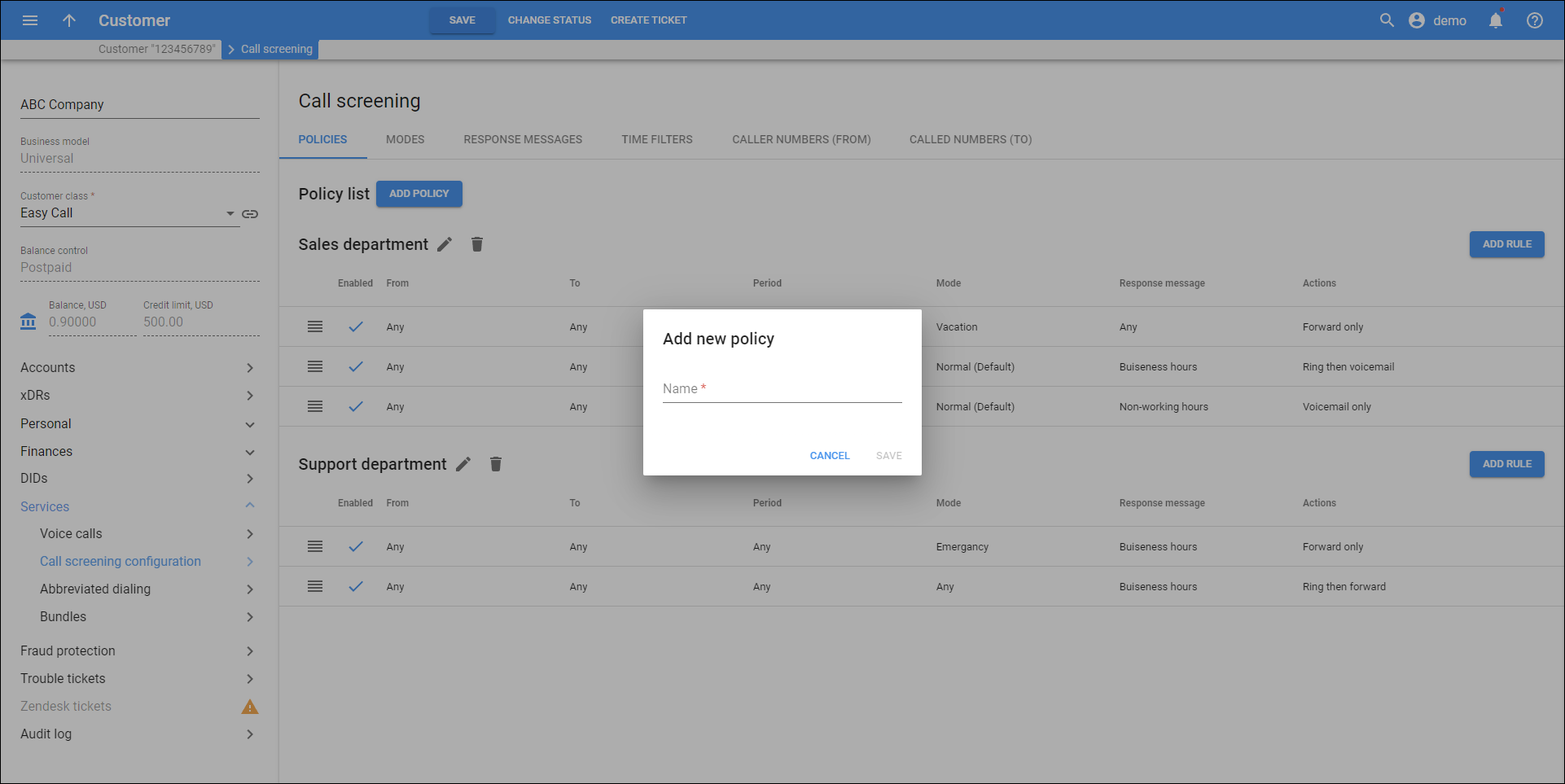On this tab, you can manage call screening policies.
Policy is a set of rules that define what call action to apply (e.g., ring, forward, voicemail) and whether to play the response message (personalized audio message to play to callers before the call is answered) depending on call time, calling/called number, and mode of the called extension.

How to add a new policy
To add a policy, click Add policy. Type the name of the policy in the dialog that opens and click Save.
You can create several policies for the PBX customer, e.g., a policy for each company department. Then you can assign a specific policy to an account.

To change the policy name, click Edit next to the policy name. In the dialog that opens, specify the new name, and click Save.
To delete a policy, click Delete ![]() . Note that you can’t delete a policy if it’s already assigned to some accounts.
. Note that you can’t delete a policy if it’s already assigned to some accounts.
How to add a new rule
A rule is a combination of conditions (e.g., time of the call, caller/called number), and specific actions that define how to process the incoming call if it matches these conditions. So, before creating a rule, you first need to define these conditions on the other tabs: Modes, Response messages, Time filters, Caller numbers (From), Called numbers (To).
Once you create a policy, you can add rules to it.
To add a rule to the policy, click Add rule and specify the details in the dialog that opens:
- Enabled – by default, the rule is enabled once created. Turn off the toggle if you want that rule to be disabled.
- From – you can select the caller by name (previously created on the Caller numbers (From) tab with the list of their numbers).
- To – you can select the called party by name (previously created on the Called numbers (To) tab with the list of their numbers, e.g., account aliases).
- Period – select the time period (previously created on the Time filter tab with the defined time conditions).
- Mode – select the one or more modes for this rule (previously created on the Mode tab with a unique Dual-Tone Multi-Frequency (DTMF) code that is used for switching extensions between modes). To select another mode, click Add
 .
. - Response message – select the response message from the dropdown list that will be played to the caller (previously uploaded on the Response messages tab).
- Actions – select actions that will be performed if a call matches the conditions specified above (the actions will be performed after playing the response message if it is set).

To edit a rule, hover over the specific rule and click Edit . Change the details in the dialog that opens.
To delete a policy rule, hover over it, and click Delete ![]() .
.
You can see the following info for the rules created within a policy:
Enabled
Shows the status of the rule. Check mark ![]() means that a specific rule is enabled.
means that a specific rule is enabled.
From
Shows the name of the calling party.
To
Shows the name of the called party.
Period
Shows the time period when the rule is applied.
Mode
Shows the modes this rule is assigned to.
Response message
Shows the name of the response message that is played to the caller.
Actions
Shows actions that are performed if the call matches the conditions specified in the policy rule.
How to change the rule order
The order of rules in the policy matters. The first rule that matches the call is applied (PortaBilling checks the rules from top to bottom by caller/callee numbers, time interval, mode of the called extension), and the other rules from the policy are ignored. To re-order rules in the policy, select a specific rule using Reorder ![]() and drag it up or down.
and drag it up or down.


